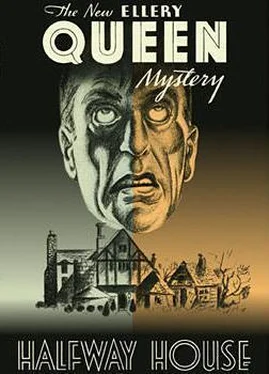“If the killer had been smoking cigarets before Andrea’s arrival, the butts and ashes should have been either in the plate on the table, on the rug, in the fireplace, or under the windows outside the shack. But they weren’t in the plate or on the table; there wasn’t a trace of even a single butt or the slightest speck of ash on the rug or anywhere inside the shack — not a shred of tobacco or anything else, for that matter. There were no burns on the carpet, such as might have been made by a foot grinding out a cigaret; and such burns would have been left even if the criminal had ground the cigarets out on the rug and then taken away the ashes and butts so ground. As for the area beneath the windows outside the shack, none were found in the muddy earth or I should have been informed, and I was definitely told that there were no footprints anywhere outside the shack except Gimball’s, indicating that the murderer had not thrown butts or ashes through a window and then retrieved them before fleeing from the scene.
“And so it was quite clear, after this analysis, that although the criminal had smoked before Andrea’s arrival, it had not been cigarets. That left,” continued Ellery with a shrug, “only a cigar or a pipe as possibilities.”
“How did you eliminate?” asked Pollinger curiously.
“Well, obviously a cigar would have left ashes, too, although not necessarily a butt. The same analysis that eliminated ashes in the case of cigarets would eliminate ashes in the case of a cigar. On the other hand, a pipe would leave no ashes at all, unless it were knocked out to dispose of the dottle, which wasn’t necessary; and besides the use of six matches was consistent with the theory of a pipe. Pipes are always going out and having to be relit. It wasn’t essential for me, however, to pin it down specifically to either a pipe or a cigar. The true significance arose from the mere elimination of cigarets, per se .”
Pollinger frowned. “Yes, yes, of course. I see that now.”
“It’s obvious, certainly. If the criminal smoked a cigar or a pipe, then the criminal was a man!”
“Beautiful.” Judge Menander nodded enthusiastically. “Quite so. A woman would naturally be ruled out by that line of reasoning. But all the evidence indicated that the criminal was a woman.”
“Then all the evidence,” retorted Ellery, “was wrong. If you rely on logic, you must stick by it or fall back on mere guesswork. The deduction pointed indisputably to a man; the evidence indicated a woman; the evidence, then, must have been either misleading or false. The evidence said a heavily veiled woman committed the crime; the deduction said: no, it was a man; therefore it was a man dressed as a woman, and the veil becomes important and significant as the essential cloak to a man’s undisguisable features.
“As a matter of fact, the more I thought over this deduction the more convinced I became of its truth. There was at least one psychological confirmation of the sex of the criminal — a small point, but it is on small points that the world’s most startling discoveries are built.”
“What was that?” demanded the judge.
“It was the curious phenomenon of the lipstick that wasn’t used,” smiled Ellery.
They were puzzled. Pollinger scrubbed his chin and said: “The lipstick that wasn’t used? By George, Queen, that sounds like something out of Doyle.”
“A handsome compliment. Surely it’s evident? We knew that the criminal, who at the time we supposed to be a woman, found it necessary in an emergency to write a note to Andrea. We knew that there were no ordinary writing implements available — I’ll take that up later — and that ‘she’ was forced to char a cork in order to write. A laborious process, eh? Well, didn’t it occur to you that every woman, almost without exception, carries with her a natural writing instrument? A lipstick? Why go through the slow and unsatisfactory process of charring a cork when all she had to do was open her bag, take out her lipstick, and write? The answer was, psychologically, that she had no lipstick. This in itself pointed to the fact that the ‘woman’ wasn’t a woman at all, but a man.”
“Well, suppose by chance this was really a woman and she didn’t carry a lipstick?” argued Judge Menander. “It’s possible.”
“Very well, it’s possible. But there was Andrea lying on the floor, unconscious! Didn’t Andrea have a bag? Didn’t Andrea, a woman, carry a woman’s natural weapon, a lipstick? Of course she did; it was unnecessary to mention it. Then why didn’t this ‘woman’ open Andrea’s bag and borrow Andrea’s lipstick to write with? The answer again was that ‘she’ didn’t think of it. But a woman would have thought of it, being a woman. Again a psychological indication of a man.”
“But lipsticks in these modern days of scientific criminology,” objected Pollinger, “can be traced by the chemical formula.”
“Can they? How nice. But then why didn’t the criminal use Andrea’s lipstick? Even if it were traced, it would be traced back to Andrea, not the criminal. No, no, no matter how you look at it, there is still psychological confirmation in this point that the criminal was a man masquerading as a woman. We now have, in fact, two points of description in the murderer’s portrait: he is a man, and he smokes most probably a pipe.”
“Beautiful, beautiful,” said the Judge again.
“Now,” said Ellery briskly. “The use of paper-matches inevitably suggested a match-packet. I asked Andrea specifically if she couldn’t remember having seen anything else on the table — with a packet in mind. Of course, the criminal might have put the packet away in his pocket, but then again he might not have done so. Remember again that Andrea’s appearance that night was unexpected and came directly after the crime when the murderer was still not finished with the bloody work at hand. Yes, said Andrea, she did remember that when she saw the six matches in the plate there was also a closed paper match-packet on the table near it. Perfect! It gave me the last clue.”
“I confess,” said the Judge ruefully, “that I don’t see how.”
“Well, perhaps you aren’t aware of a further fact which also came out in Andrea’s story the other day. That was that when she recovered consciousness, the packet was gone. Now, if it was gone, the criminal had taken it away. Why?”
A little flicker of interest disturbed the beatific expression on Bill’s face. “Why not, El? Smokers do that all the time. Especially pipe-smokers; they’re always running short of matches. They use the packet and put it right back in their pockets.
“ Touché, ” murmured Ellery, “but not in a vital spot, my son. Putting it back in your pocket implies that there are still matches left in the packet, n’est-ce pas? ”
“Of course!”
“But you see,” said Ellery gently, “there couldn’t have been any matches left in the packet the criminal first used.”
“Hold on, young man,” said the Judge in haste. “This seems to be the magic I referred to. How do you arrive at that remarkable conclusion?”
“By a simple process. How many matches were found in the plate — all the matches, those used for smoking and those used for charring the cork?”
“Twenty, I believe.”
“How many matches are there in these cheap, common, universal match-packets?”
“Twenty.”
“Precisely. What does that mean? That means that at least one packet of matches was fully depleted by the criminal in the shack that night. Even if the criminal didn’t start with a full, fresh packet but with, say, a packet already started and having only ten matches left, and then pulled out another packet to complete the total of twenty found, the first packet would have been emptied in the process.
Читать дальше












